This message is a photographic essay on one of my favorite plants, Houstonia caerulea (Hedyotis caerulea), common name Bluets, a member of the Rubiaceae.
While H. caerulea is not generally thought of as an alpine plant, it does grow up into the mountains, and depending on whether one considers H. caerulea var. faxonorum valid or not, the genus does get up into alpine zones in the White Mts of New Hampshire. There are choice mountain species in Western USA as well. At any rate, H. caerulea is such a tiny bun-forming plant and blooming for such a long period, that it certainly warrants a place in the rock garden.
Ubiquitous in Eastern USA and here in Massachusetts (Northeastern USA), it is extremely variable, always charming, yet perhaps because it is so common, the plant is largely underappreciated. Nor has the great range of variability been explored, documented, and enacted upon. Typically seen growing on sunny to partially shaded highway embankments in areas with poor soil that support only sparse grass and mosses, it is a familiar sight in its most insignificant manifestation, a mere wisp of a plant making filmy sprays of tiny white or faintly bluish flowers.
But I have seen specimens that dazzle the eye and spark the imagination, a rock gardener's dream to be sure. Typically such spectacular plants, as I have spotted them, are growing in moist locations in neighborhood lawns amongst lush, deep green spring grass, where trespasser's shall not venture, but the eye strains for glimpses of 6" round domed mounds of pristine white, as if imitating Aretian Androsace, at least from afar, but merely growing in someone's lawn! The prospect so close, yet unreachable. I imagine knocking on someone's door with what would surely seem a bizarre and suspect request to gain access to these magnificent domes of white, for a petite snippet, when they are mere "weeds" in someone's un-mown spring lawn.
Occasionally serendipity happens. On an unusually hot Sunday afternoon late April 2009, I ran a local 10k road race in Groton, Massachusetts. After the race, I walked back to a large business where runners were allowed to park. I crossed the multi-acre lawn in front of the business, approaching a partly sunny hollow at the edge of a grove of mature trees, and there before me was a fantastic colony of Houstonia caerulea. These were in a somewhat drier site without the luxuriant hemispherical domes mentioned previously, but nonetheless an exciting colony of variable Bluets.
Let me share some photos exploring the diversity of this colony. Most were pure white, but some light blues were present too. In western Massachusetts, I have seen some very deep blue forms indeed, but none of such color were to be found here, however the range of flower size, impressive floriferousness ratio on some plants, and forms with tight foliage masses, more than compensated. What this colony revealed to me was, the superior forms with extraordinary flower count were not necessarily a factor of soil and moisture, but were indeed genetically separate individual plants where one could select superior forms. I hope to have some of these growing in my lawn soon!

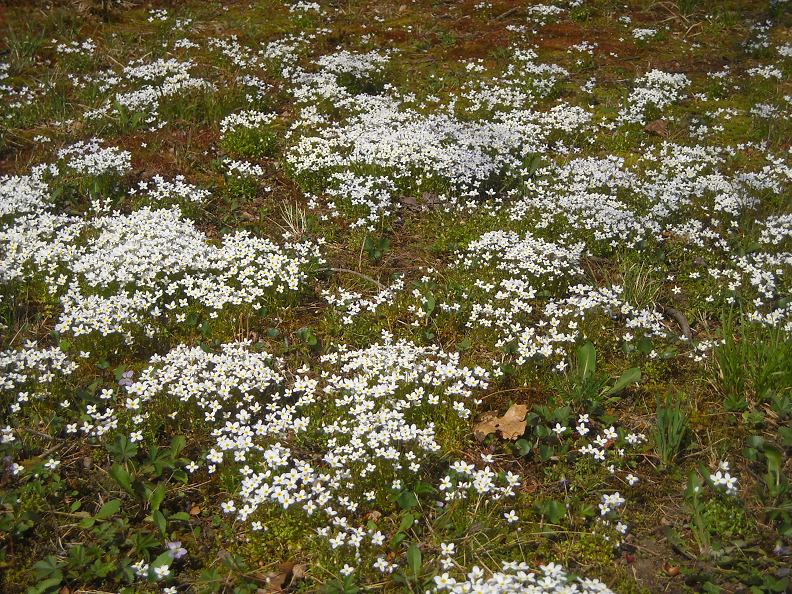
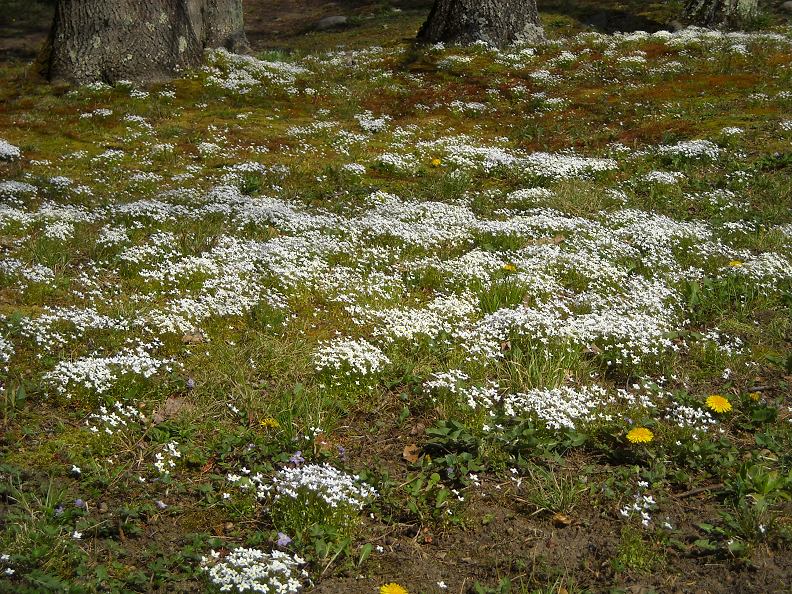
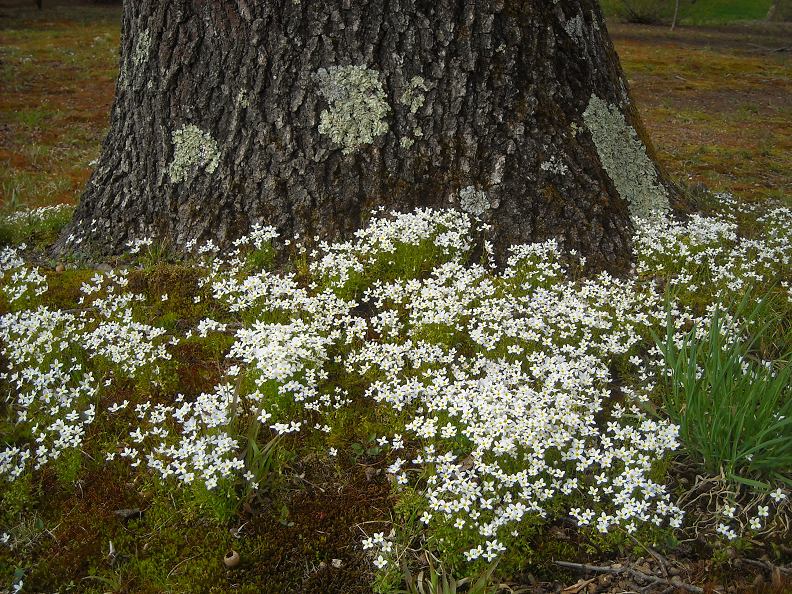



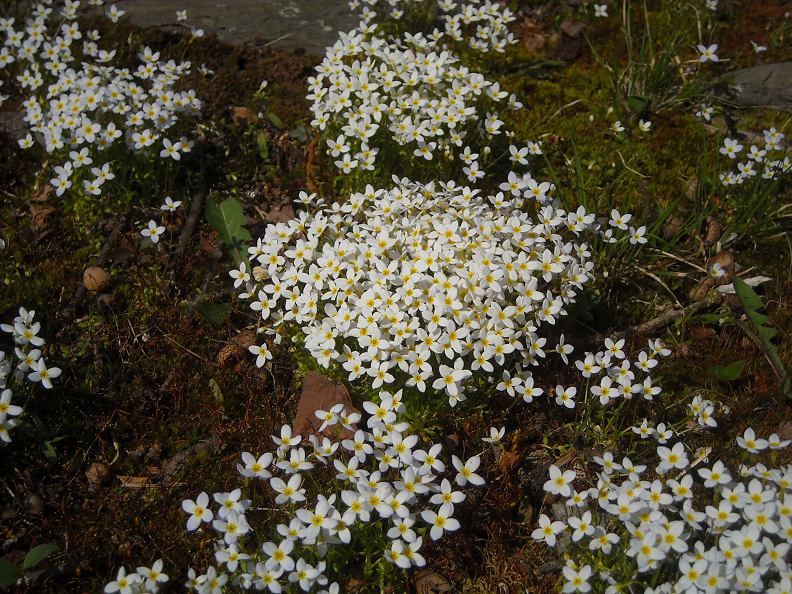

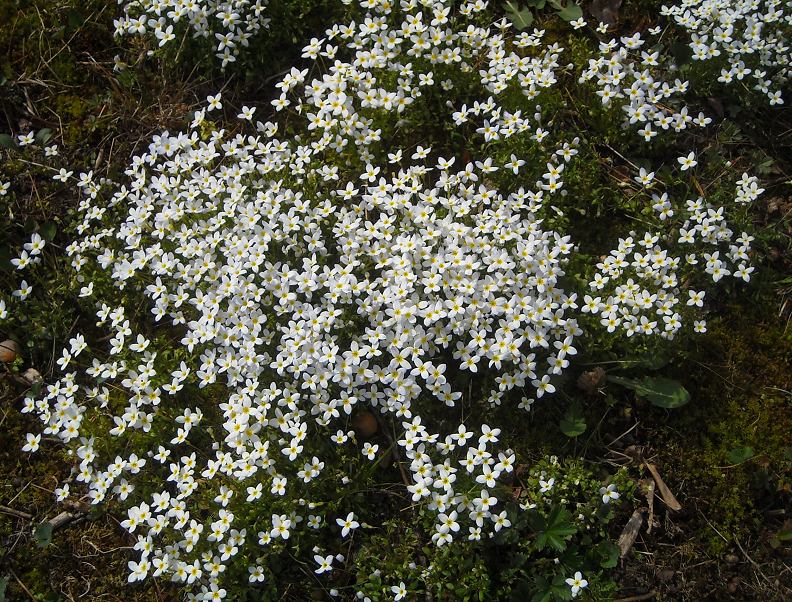

Comments
Mark McDonough
Re: Houstonia caerulea (Bluets) - a photographic essay
Wed, 03/03/2010 - 8:31amYesterday, March 02, 2010, when some of the ice-snow pack retreated from part of the yard and garden, the buns of Houstonia caerulea become uncovered, and to my surprise, there were still vital seed pods and a few fresh flowers nestled tight to the clump. I share this photo with you.
And in the following link we see a good blue-flowered form by SRGC member Helen Poirier, living in New Brunswick, Canada.
http://www.srgc.org.uk/smf/index.php?action=dlattach;topic=4790.0;attach...
Trond Hoy
Re: Houstonia caerulea (Bluets) - a photographic essay
Wed, 03/03/2010 - 9:26amI have tried Houstonia a couple of times but they always peter out in a year or two. Maybe they don't like wet winters? I have to try once more. Should like them to self-sow!
Richard T. Rodich
Re: Houstonia caerulea (Bluets) - a photographic essay
Wed, 03/03/2010 - 7:42pmOur native Minnesota species of Houstonia grows in the same areas as other alpine like plants here. For instance, it grows in the same crevice work as Coryphantha viviparia and Opuntia fragilis. I never thought about it growing in lawns, nor have I seen it here invading sparse turf. I don't think ours is evergreen.
Lori S. (not verified)
Re: Houstonia caerulea (Bluets) - a photographic essay
Wed, 03/03/2010 - 9:47pmI've only ever had Houstonia caerulea come back in an acid bed, and only once at that. Does it favour acid (or at least neutral) soil, as opposed to higher pH? The natural conditions here are alkaline, pH 8 or higher.
Richard T. Rodich
Re: Houstonia caerulea (Bluets) - a photographic essay
Thu, 03/04/2010 - 3:59pmNow I am not sure which species(s) we have in Minnesota. I've never looked close enough to see if stamens were attached to the corona or not, or exerted, but the overall growth pattern points to H. longifolia. I have observed them in northeastern and southern MN. One MN flora text from the 1960's only list longifolia as extant in northern MN, not mentioning caerulea at all. A Spring Flora of Wisconsin lists both species, with caerulea in the sounthern part of that state. I'll have to look closer. A trek to SW MN is on my to do list this June. I may even catch the Coryphantha vivipara in bloom.
At any rate, the hustonia in sw MN grow in neutral to alkaline, dry soil. In ne MN, they are in acid dry soil. Without anything to back up my decision except the general growth pattern, I am guessing both are longifolia.
Mark McDonough
Re: Houstonia caerulea (Bluets) - a photographic essay
Thu, 03/18/2010 - 4:56pmRick, if you go looking for the H. aff. longifolia, would the plants still be in bloom in June? Here, at least with caerulea, they bloom early (April-May). If you do find what you believe to be longifolia, I would like very much to see some close-up photos, I'm not familiar with that species. Maybe collect some seeds if any pods are available.
Mark McDonough
Re: Houstonia caerulea (Bluets) - a photographic essay
Thu, 03/18/2010 - 5:00pmWith the diverse colony of H. caerulea shown in my photo essay, I did collect some "snippets" from those plants with a bun-like habit versus those that grew more loose and spreading. They quickly "bunned up" in the garden, but I was surprised to see two different leaf color forms, one is red-leaved in winter and early spring, and others are green. Here are both color forms in a side-by-side composed view, photo taken today, 03-16-2010.
Panayoti Kelaidis
Re: Houstonia caerulea (Bluets) - a photographic essay
Thu, 03/18/2010 - 6:15pmNow I have to wade through my oceans of images to extract a few to prove Houstonia caerulea tolerates the desolate wastes of mid America: We finally succeeded with by planting it in a BOG with Pitcher plants and Dactylorhize majalis! I had great luck with Houstonia serpyllifolia when I lived in Boulder: it filled a big scree with its mats and their dazzling azure blooms: I really like that plant. It grew very well with various trumpet and star gentians. Our Western Houstonias are all being called Hedyotis it seems: they are not generally as cute, except for the adorable tiny Hedyotis rubra from the high Chihuahuan desert and steppe where it can be very common: I find it impossible to grow.
Loved your photo essay, Mark: really fleshed out the images I had of Houstonia caerulea in my mind: I have seen it here and there in my Eastern spring visits, but not like your fabulous stands. Local nurseries sell it, I suspect because it is irresistible to customers! I suspect not many have it come back...
Richard T. Rodich
Re: Houstonia caerulea (Bluets) - a photographic essay
Thu, 03/18/2010 - 7:47pmYes Mark, the Housonia sp. I a speak of should be blooming in late June with the Coryphantha viviparia in SW MN. It's normal bloom time is early to mid summer here. I'll watch for seed, too.
Marianne Kuchel
Re: Houstonia caerulea (Bluets) - a photographic essay
Wed, 03/24/2010 - 7:51amHi Mark,
I tried very unsuccessfully to post something here yesterday, but it did not work. I wanted to show a Houstonia I had grown from seed and that is coming back again this spring. I will have to work on using attachments. Anyway Housonia is also growing wild here in Vermont.
Marianne
Fairlee, Vermont
Mark McDonough
Re: Houstonia caerulea (Bluets) - a photographic essay
Wed, 03/24/2010 - 8:00amMarianne, try the steps I mention in your other posting where you describe some difficulties uploading images, click this link to see my response:
http://nargs.org/smf/index.php?topic=4.msg1151#msg1151
I'd very much like to see your Houstonia photo, so try the steps I describe, then report back with details about what the specific problems might be... let me know how far you get in the steps I describe. Also, are you using a Mac or a PC?
Trond Hoy
Re: Houstonia caerulea (Bluets) - a photographic essay
Wed, 03/24/2010 - 10:04amI have decided to try your Bluets once more if I find any for sale or seed. Does the Bluets come in bluer color? If I remember right those I have tried were bluer than shown in your pictures Mark, or does the pictures (or my screen) lie?
Mark McDonough
Re: Houstonia caerulea (Bluets) - a photographic essay
Wed, 03/24/2010 - 10:22amMost often bluets are white lightly shaded with blue, although as you can see in the populations near me, there are pure whites, and some very pale blues too. There are forms with much deeper blue color, but I don't have any of those yet, but I do want to get a good blue one day. Check the link below for a good blue form.
Previously I posted the following link to a good blue-flowered form by SRGC member Helen Poirier, living in New Brunswick, Canada.
http://www.srgc.org.uk/smf/index.php?action=dlattach;topic=4790.0;attach...
Trond Hoy
Re: Houstonia caerulea (Bluets) - a photographic essay
Wed, 03/24/2010 - 11:14amYes! That is the color I remember of the plants I bought once. Thanks. I will try to get hold of different colors, maybe better chance for crossing and better viable seed.
Marianne Kuchel
Re: Houstonia caerulea (Bluets) - a photographic essay
Wed, 03/24/2010 - 2:58pmHi Mark -- Thanks for your help. I will learn how to post pics eventually. I am using a new Mac and I am having trouble changing from a PC. My Houstonia photo will probably arrive when everyone stops talking about them.
Marianne
Mark McDonough
Re: Houstonia caerulea (Bluets) - a photographic essay
Thu, 04/01/2010 - 6:17amScanning through my digital photo library, I came upon two more photos of Houstonia caerulea in a rock garden setting, taken in a friend's garden, one is white and the other is light blue.
Mark McDonough
Re: Houstonia caerulea (Bluets) - a photographic essay
Thu, 04/08/2010 - 8:41pmThe abnormally hot weather and string of sunny days pushed things along faster than usual, and suddenly the Houstonia caerulea plants are starting into their main flush of flowering.
It is interesting that the winter-green bun turns out to be bluest form, whereas the winter red-leaf bun turns out to be white ever so slightly tinged blue. The bluest one also has flowers 2-3 times larger than the others.
Trond Hoy
Re: Houstonia caerulea (Bluets) - a photographic essay
Fri, 04/09/2010 - 12:53amWe have the usual dull weather, neither hot nor cold, neither sun nor rain! The forecast is more sun from today, but not high temperatures (about 10C at day and 4C at night).
Don't you think the whitest forms lack pigments (carotenoids) in their leaves too? They have to compensate making anthocyanins instead.
Mark McDonough
Re: Houstonia caerulea (Bluets) - a photographic essay
Sat, 04/10/2010 - 11:20amThis shot taken specifically to show the degree of slope these are planted on. I'm delighted, they have seeded around from last year's planting, and lots of babies coming up... they'll flower no matter how tiny a young plant they are.
Mark McDonough
Re: Houstonia caerulea (Bluets) - a photographic essay
Wed, 04/14/2010 - 7:17amSome more views as the plants are starting to "flower up a storm". More and more single baby seedlings appear, each putting up a single sweet floret. The eventually goal is to have bluets as an underplanting to my various Trillium species.
An interesting phenomenon I have observed first hand, is the deepening of flower color, some that were basically white with the slightest hint of blue, have become decidedly blue. Not sure if this is due to the weather, soil, or just a naturally occurring feature.
John P. Weiser
Re: Houstonia caerulea (Bluets) - a photographic essay
Wed, 04/14/2010 - 2:12pmmark
I agree that H. caerulea does not get the credit it deserves. We always want what is hard to grow! 8)
I tried H. caerulea last year for the first time. Planted in the full shade of my moist north facing bed with sprinklers set to go off twice a day every other day. It did well in the spring and was still alive in the fall but no sign of it this spring. I will have to try Panayoti's method and grow it as a bog plant in dappled shade. I wonder if our humidity is too low?? I know that even with the water I put down, the ground was never what I would call wet for more than half a day. I thought full shade would work better since we are at 4000' and the UV rays are intense. So intense more than one occasion badly sun burned cacti cuttings from lower elevation sights.
Trond Hoy
Re: Houstonia caerulea (Bluets) - a photographic essay
Wed, 04/14/2010 - 11:42pmI have tried bluets twice but they disappear after a year or two. And the humidity here is certainly not too low! On the contrary I think of trying this little gem on drier land and with more sun.
Harold Peachey
Re: Houstonia caerulea (Bluets) - a photographic essay
Thu, 04/15/2010 - 3:32amI was in Marcellus NY yesterday (yes that Marcellus of the shale) and observed entire neighborhoods with Houstonia carpets right in the lawns. I have started some from seed from the sewed ex and hope to establish them in my ever diminishing lawn.
Mark McDonough
Re: Houstonia caerulea (Bluets) - a photographic essay
Thu, 04/15/2010 - 4:47amHarold: glad to hear you have an ever diminishing lawn, I've got one of those too ;D Yes, the frustrating part of Houstonia, it always seems that the best looking ones grow in other people's lawns. That said, I'm convinced with my find of an extraordinary colony of H. caerulea here locally, that there is definitely genetics involved; there are forms that clump up and flower prolifically, seed well, and appear to be strong growers, too often there are weak forms that bloom more sparsely and tend to be short-lived. So, one never knows where the seed comes from through Seedexes. I do hope to collect seed from my plants, to donate to NARGS, as I've never seen such excellent forms before. I shall also be revisiting the colony in a week and a half with my running shoes on and camera in hand, the day of the Groton 10K Road Race.
Trond: yes, for your climate I suggest trying Houstonia in more sun, and in a drier spot. The best ones are typically in full sun to high, open, partial dappled shade.
John: I don't know how to advise you to grow Houstonia caerulea in your 6"-per-year of rain desert climate. Perhaps the reverse of what I recommend for Trond, do as you suggest and grow in shade or dappled shade. Not sure about the bog thing though, these tend to be dry growers, although they can luxuriate in moister soil while growing first thing in spring. Just as an experiment, try growing in partial shade in a clay soil. As an aside, you might also have a better chance than those of us in wetter climates, to grow Houstonia rubra, a small bun-forming western dryland species.
Good luck everyone growing this plant... the first thing I do each day when going out to the garden, is run over to my fledgling Hosutonia colony and gaze for a while :D
John P. Weiser
Re: Houstonia caerulea (Bluets) - a photographic essay
Thu, 04/15/2010 - 7:31amMark
Luckily! I have a pot sown with H. rubra. I have my fingers crossed. They are cute little things! From the shot I saw the flowers are flat, pale pink, four bladed pinwheels. They have a stiff, waxy look.
The leaves are narrow gray/green succulent fingers, typical dry climate adaptations.
I have high hopes of growing it.
Mark McDonough
Re: Houstonia caerulea (Bluets) - a photographic essay
Wed, 04/28/2010 - 4:54amOn then anniversary of my finding a terrific Houstonia caerulea patch, this past weekend I once again entered a 10k roadrace, followed by scouting around the grounds of a business that allowed runners to park and shuttle from. I found a couple different patches of Houstonia, but in one wooded hollow just in front of the building, there were drifts of Anemone quinquefolia in flower, and the diminutive Panax trifolius.
1. View of the deciduous wooded hollow and driveway passing around it. Here Houstonis grew best at the fringes where they received more light, and were fiound as only small individual non-clumping plants in the shadier spots.
2. Small and large patches of Anemone quinquefolia, very attractive but short-lived in bloom.
3. Only a little bit of variation with A. quinquefolia, there were dark-leaf forms, but with normal white flowers.
4. There were a few A. quinquefolia tinged pink on the back of the petals. Flowers that go over, turn beige.
5. A. quinquefolia, Panax trifolius, and Linnaea borealis
6. View of woodland edge, with variable populations of Houstonia caerulea.
7-9 Variable forms of Houstonia caerulea
10. Lots of bluets, can you spot the one 5-petalled flower... it is just an aberration on normal 4-petalled plants.
Trond Hoy
Re: Houstonia caerulea (Bluets) - a photographic essay
Wed, 04/28/2010 - 12:30pmYou had to do a fast run to have time to look for flowers!
Reminds me of once I was looking for plants in a wood here and came "exploding" out of a thicket just in front of a unsuspecting lady (had not seen her) walking on the path. I think she is still running...
The Houstonias are marvellous! And the A. quinquefolia too. They are a little different from A. nemorosa. Panax trifolius looks like a fine woodland plant (I am always hunting for plants that will grow in my woodland).
Mark McDonough
Re: Houstonia caerulea (Bluets) - a photographic essay
Fri, 04/30/2010 - 6:58amAfter a full month of flowering, the plants are getting bigger and more floriferous than I imagined they would, there appears to be no end of flowering in sight. They have certainly exceeded my expectations. And I'm glad too, that my attempt to pick snippets off a variety of forms has paid off, as under more optimal conditions without competition from grass, their special characteristics become amplified. The large-flowered blue one has petals that curve upwards, thus has a different look to the flowers.
Trond Hoy
Re: Houstonia caerulea (Bluets) - a photographic essay
Sun, 05/02/2010 - 11:07amYou are tempting me!
Harold Peachey
Re: Houstonia caerulea (Bluets) - a photographic essay
Mon, 05/09/2011 - 5:09pmI got this plant last year as Houstonia serpyllifolia very nice blue growing an a small bog garden.
Mark McDonough
Re: Houstonia caerulea (Bluets) - a photographic essay
Mon, 05/09/2011 - 5:31pmVery nice Harold, a good clear blue color, I like it, wish I had some as blue as that! Hopefully it'll seed around for you.
I'm starting to tuck little bits of H. caerulea at the edges of woodland paths, in the tiniest of spots between rocks and logs, and they look so perky and natural. Here is one such scenario:
Trond Hoy
Re: Houstonia caerulea (Bluets) - a photographic essay
Wed, 05/11/2011 - 12:18amVery cute flowers!
Can hardly wait for my seedlings to appear ;D
externmed (not verified)
Re: Houstonia caerulea (Bluets) - a photographic essay
Thu, 06/02/2011 - 11:24amFunny how they thrive in barren compacted clay soil, but die out in garden soil, at least in my part of Massachusetts. Occasionally get a few in the lawn, too.
"Solarized" a patch of barren soil and they bloomed there next spring, suggesting that plants germinating in the early fall can flower the next spring.
Charles Swanson NE Massachusetts
Mark McDonough
Re: Houstonia caerulea (Bluets) - a photographic essay
Fri, 11/25/2011 - 7:01pmLate in the season, Houstonia caerulea retracts into a basal cushion of foliage. Older plants tend to die off, so I would call this species a short-lived perennial, fortunately seedlings are popping up here and there, which I welcome. In the first photo you can see some seedling plants off to the right of a parent plant, with some dried flower stem remnants. In the photo on the right is a mound that flowered prolifically all spring and well into the summer, showing a profusion of dried stem remnants, the mound looking strong and hunkered down for the winter.
Mark McDonough
Reviving an old post here.
Sun, 11/17/2013 - 7:53pmReviving an old post here. Yesterday I potted up a dense domed hummock of Houstonia careulea, plus a couple seedling clumps from it, into a clay pot, to enjoy the evergreen mounds over winter on my deck. The pot is from Grand Ridge Nursery (Phil Pearson, Steve Doonan) of Issaquah Washington, that I brought back with me when I returned to Massachusetts in 1986 after a 4 years living near Seattle Washington. These pots are special, beautiful high-fire pots designed to resist winter breakage, intended for alpine plants; 26 years years outside and planted and still intact. Using indigenous rock (all I need to do is dig a hole to unearth lots and lots of such rocks), the stone mulch, while appearing a different color, is the same crumbling rock that I break up with a hammer.
Not all Houstonia caerulea clump up so nice and dense, many grow as wispy little nothings, but those that do tend to grow densely are genetically stable, and make wonderful little cushions that look great all winter. In spring they will flower for more than 2 months, smothered with short-stemmed clouds of white tinged blue.